Abstract
OBJECTIVE--To study the incidence, predisposing factors, and clinical significance of arrhythmias early and late after the Fontan operation for congenital heart disease. PATIENTS AND METHODS--All 104 consecutive patients undergoing Fontan repair from 1975 to 1988 were studied retrospectively. Hospital records were reviewed for perioperative arrhythmia. Clinical information and annual electrocardiograms were available for all 78 hospital survivors during a follow up of up to 13 years (mean 3.7 years). Ambulatory electrocardiographic monitoring was performed in 67 patients (81%). RESULTS--Eleven patients (10.6%) developed a perioperative tachycardia (eight, atrial flutter; three, His bundle tachycardia). Multivariate analysis showed that raised preoperative mean pulmonary artery pressure and low aortic saturation were significant risk factors for the development of atrial flutter (r2 = 0.32, p = 0.0001) but not for His bundle tachycardia. Despite intensive medical treatment 10 of these 11 patients died. At the last visit 72 (92%) of the 78 patients were in sinus rhythm on their standard 12 lead electrocardiogram. Junctional rhythm was present in three patients, two patients had atrial flutter, and one had a paced rhythm. Ambulatory monitoring did not show important bradycardia or ventricular arrhythmias. Actuarial survival free of supraventricular arrhythmia was 82% at eight years after operation. Multivariate analysis identified older age, increased right atrial size, and raised mean preoperative pulmonary artery pressure as risk factors for arrhythmia during intermediate follow-up (r2 = 0.46, p less than 0.001). Late tachycardias, in contrast to those occurring in the perioperative period, were not associated with an increased mortality. CONCLUSIONS--Except for his bundle tachycardia in the perioperative period, early and late arrhythmias after a Fontan operation seem to be a consequence of adverse preoperative and postoperative haemodynamic function. The perioperative outcome is therefore poor even when the patient can be restored to sinus rhythm. Medical and surgical modifications to improve the haemodynamic disturbances associated with arrhythmias are therefore indicated.
Full text
PDF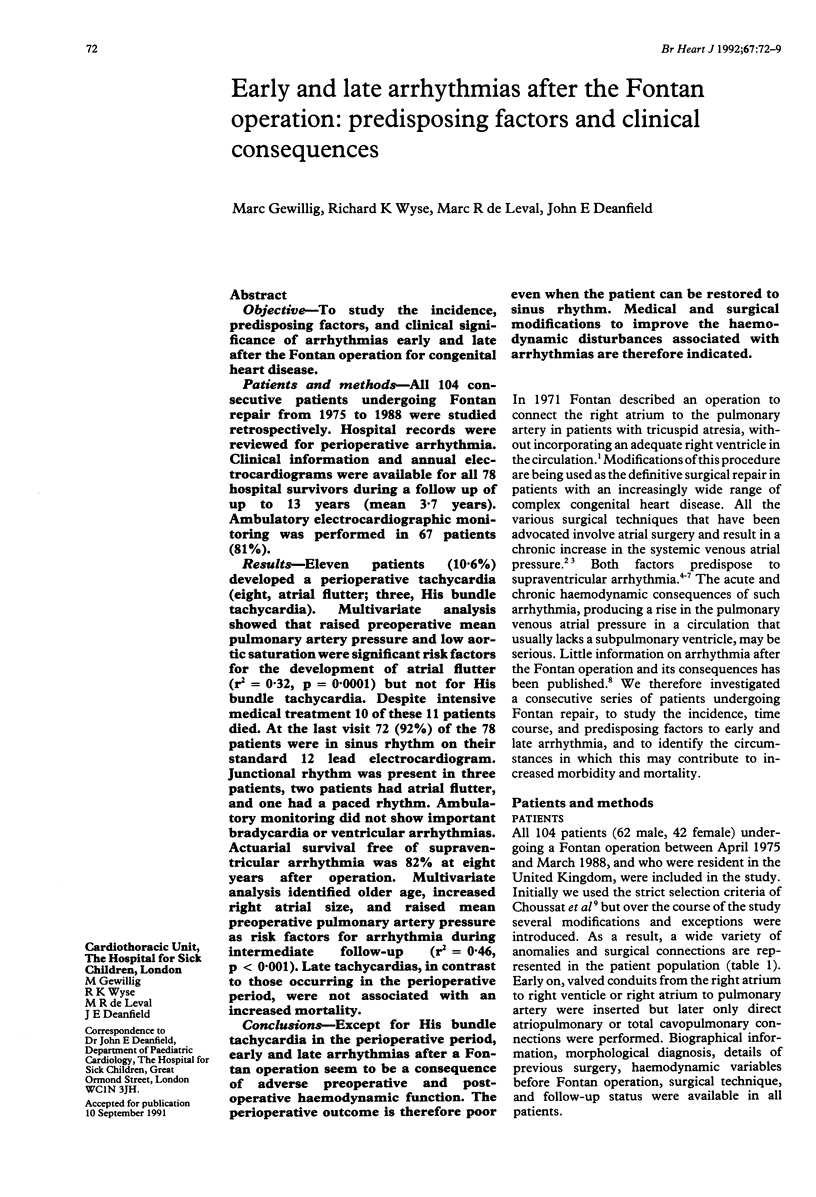
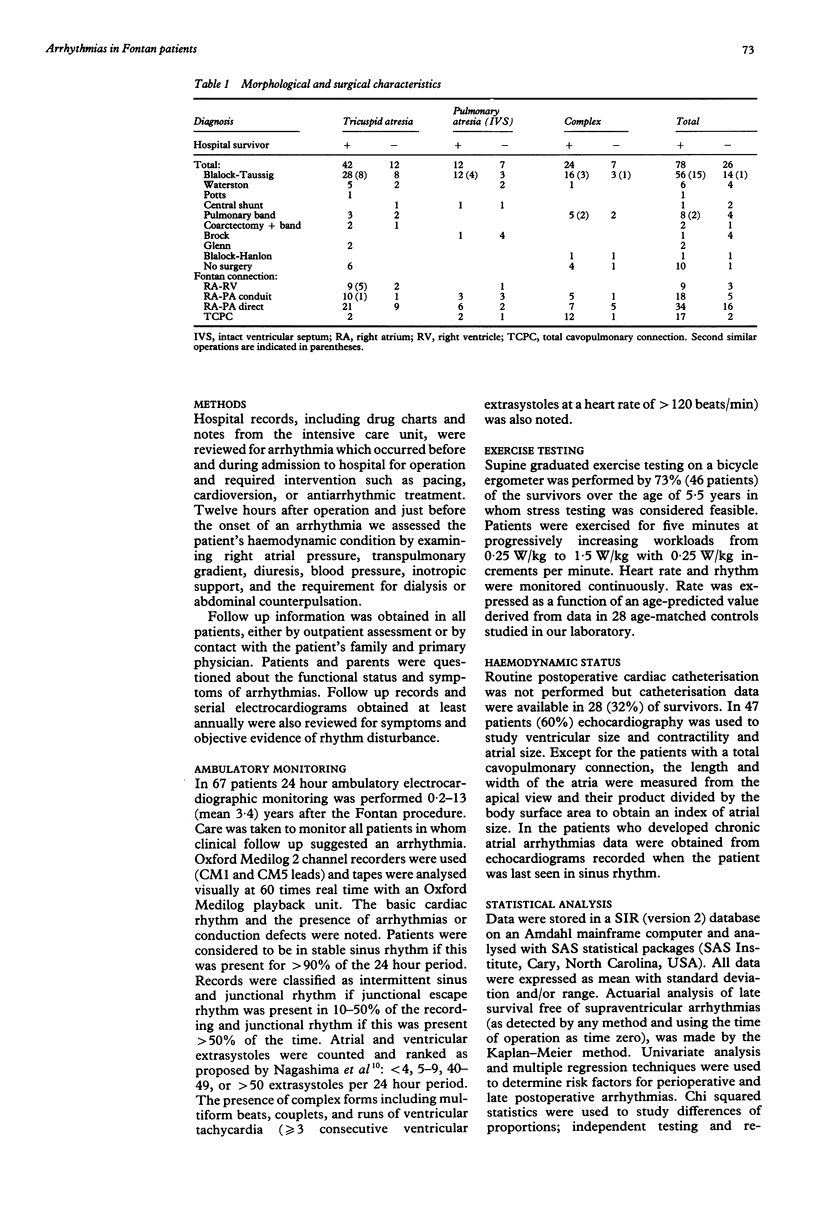
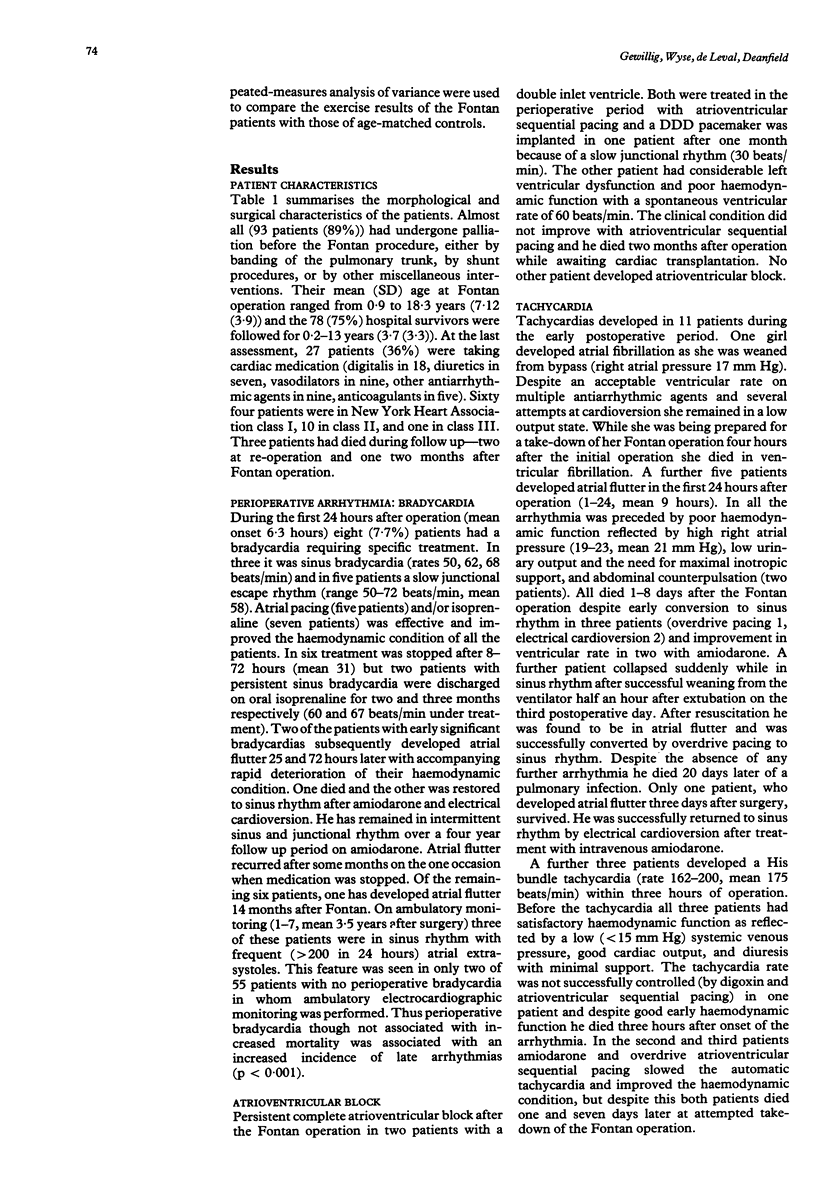
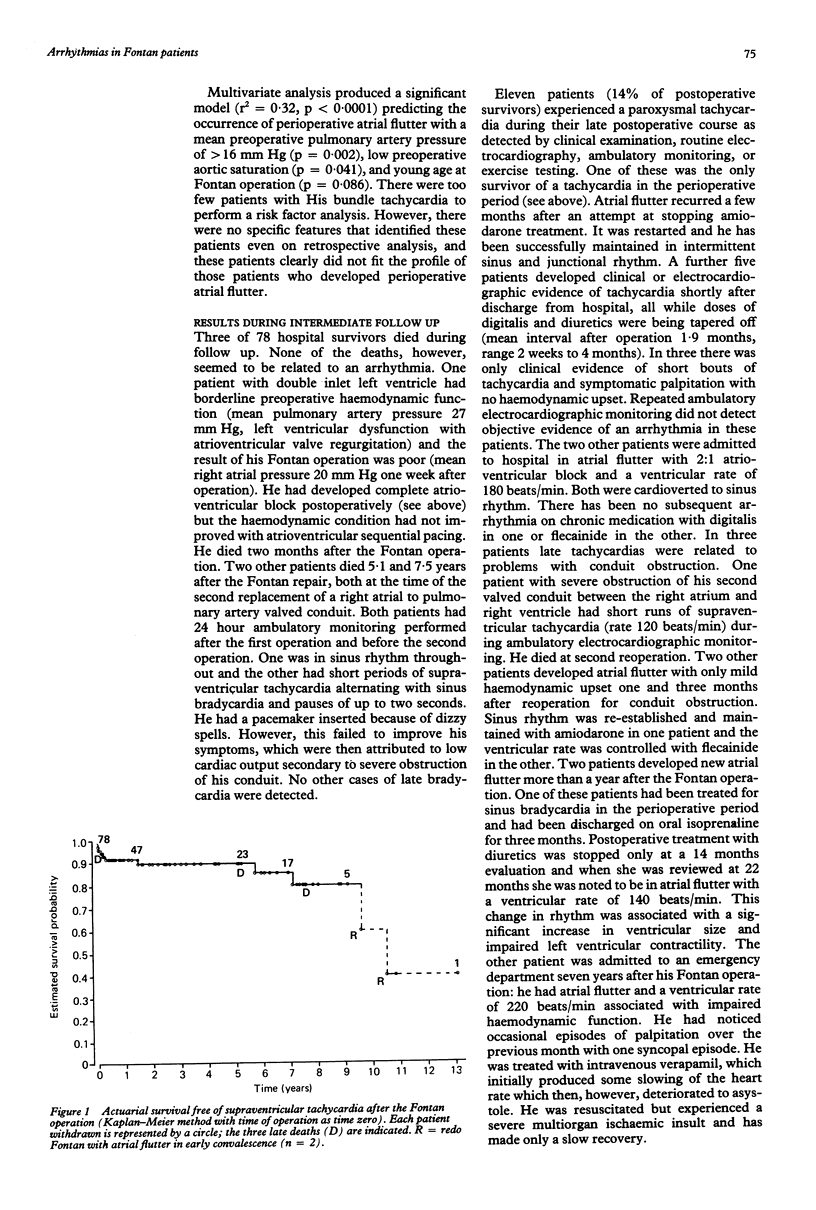
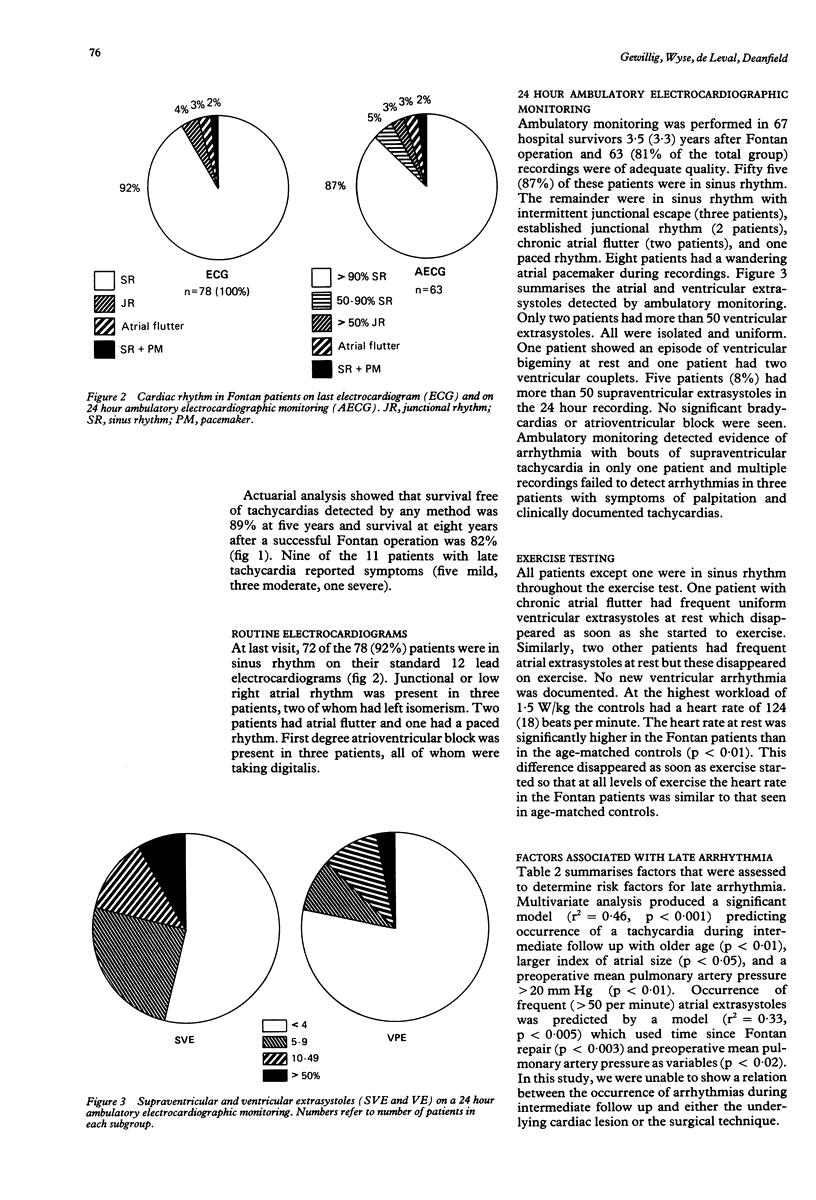
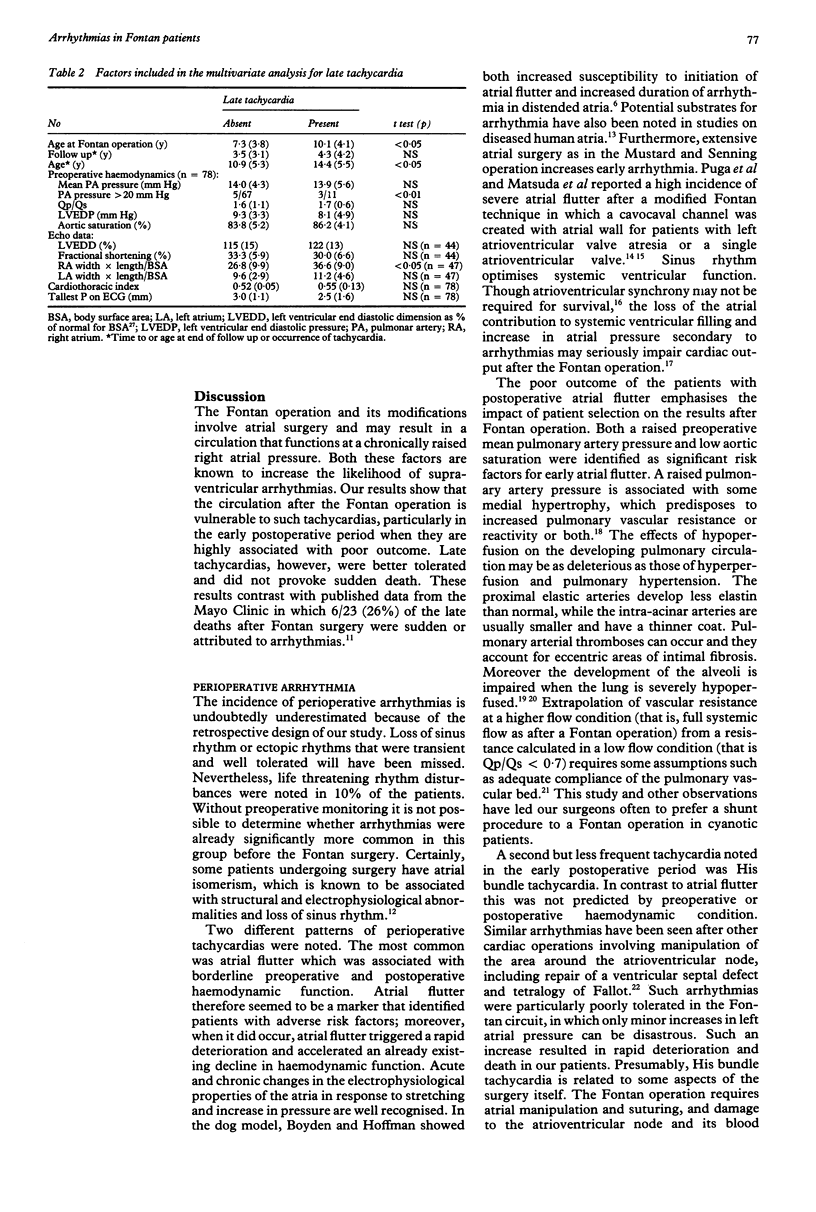
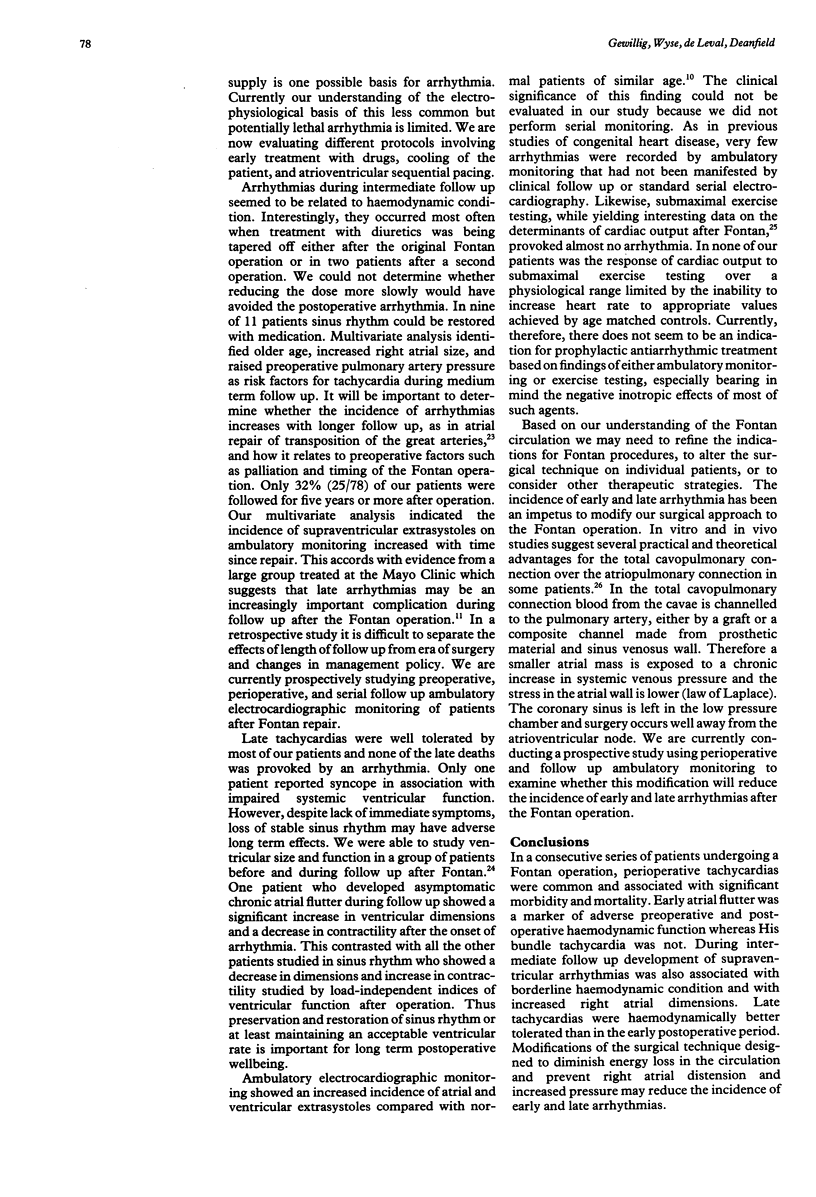
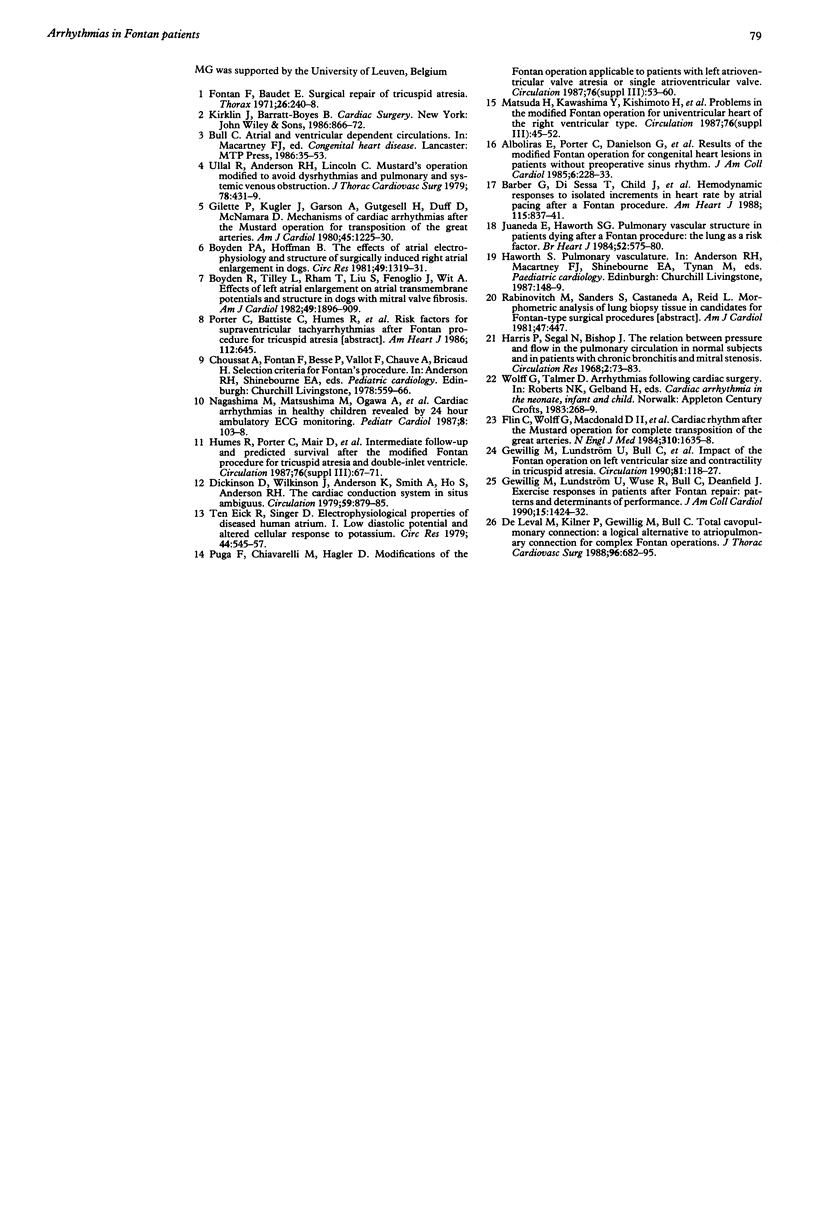
Selected References
These references are in PubMed. This may not be the complete list of references from this article.
- Alboliras E. T., Porter C. B., Danielson G. K., Puga F. J., Schaff H. V., Rice M. J., Driscoll D. J. Results of the modified Fontan operation for congenital heart lesions in patients without preoperative sinus rhythm. J Am Coll Cardiol. 1985 Jul;6(1):228–233. doi: 10.1016/s0735-1097(85)80280-1. [DOI] [PubMed] [Google Scholar]
- Barber G., Di Sessa T., Child J. S., Perloff J. K., Laks H., George B. L., Williams R. G. Hemodynamic responses to isolated increments in heart rate by atrial pacing after a Fontan procedure. Am Heart J. 1988 Apr;115(4):837–841. doi: 10.1016/0002-8703(88)90887-3. [DOI] [PubMed] [Google Scholar]
- Boyden P. A., Hoffman B. F. The effects on atrial electrophysiology and structure of surgically induced right atrial enlargement in dogs. Circ Res. 1981 Dec;49(6):1319–1331. doi: 10.1161/01.res.49.6.1319. [DOI] [PubMed] [Google Scholar]
- Boyden P. A., Tilley L. P., Pham T. D., Liu S. K., Fenoglic J. J., Jr, Wit A. L. Effects of left atrial enlargement on atrial transmembrane potentials and structure in dogs with mitral valve fibrosis. Am J Cardiol. 1982 Jun;49(8):1896–1908. doi: 10.1016/0002-9149(82)90208-9. [DOI] [PubMed] [Google Scholar]
- Dickinson D. F., Wilkinson J. L., Anderson K. R., Smith A., Ho S. Y., Anderson R. H. The cardiac conduction system in situs ambiguus. Circulation. 1979 May;59(5):879–885. doi: 10.1161/01.cir.59.5.879. [DOI] [PubMed] [Google Scholar]
- Flinn C. J., Wolff G. S., Dick M., 2nd, Campbell R. M., Borkat G., Casta A., Hordof A., Hougen T. J., Kavey R. E., Kugler J. Cardiac rhythm after the Mustard operation for complete transposition of the great arteries. N Engl J Med. 1984 Jun 21;310(25):1635–1638. doi: 10.1056/NEJM198406213102504. [DOI] [PubMed] [Google Scholar]
- Fontan F., Baudet E. Surgical repair of tricuspid atresia. Thorax. 1971 May;26(3):240–248. doi: 10.1136/thx.26.3.240. [DOI] [PMC free article] [PubMed] [Google Scholar]
- Gewillig M. H., Lundström U. R., Bull C., Wyse R. K., Deanfield J. E. Exercise responses in patients with congenital heart disease after Fontan repair: patterns and determinants of performance. J Am Coll Cardiol. 1990 May;15(6):1424–1432. doi: 10.1016/s0735-1097(10)80034-8. [DOI] [PubMed] [Google Scholar]
- Gewillig M. H., Lundström U. R., Deanfield J. E., Bull C., Franklin R. C., Graham T. P., Jr, Wyse R. K. Impact of Fontan operation on left ventricular size and contractility in tricuspid atresia. Circulation. 1990 Jan;81(1):118–127. doi: 10.1161/01.cir.81.1.118. [DOI] [PubMed] [Google Scholar]
- Gillette P. C., Kugler J. D., Garson A., Jr, Gutgesell H. P., Duff D. F., McNamara D. G. Mechanisms of cardiac arrhythmias after the Mustard operation for transposition of the great arteries. Am J Cardiol. 1980 Jun;45(6):1225–1230. doi: 10.1016/0002-9149(80)90482-8. [DOI] [PubMed] [Google Scholar]
- Harris P., Segel N., Bishop J. M. The relation between pressure and flow in the pulmonary circulation in normal subjects and in patients with chronic bronchitis and mitral stenosis. Cardiovasc Res. 1968 Jan;2(1):73–83. doi: 10.1093/cvr/2.1.73. [DOI] [PubMed] [Google Scholar]
- Juaneda E., Haworth S. G. Pulmonary vascular structure in patients dying after a Fontan procedure. The lung as a risk factor. Br Heart J. 1984 Nov;52(5):575–580. doi: 10.1136/hrt.52.5.575. [DOI] [PMC free article] [PubMed] [Google Scholar]
- Nagashima M., Matsushima M., Ogawa A., Ohsuga A., Kaneko T., Yazaki T., Okajima M. Cardiac arrhythmias in healthy children revealed by 24-hour ambulatory ECG monitoring. Pediatr Cardiol. 1987;8(2):103–108. doi: 10.1007/BF02079464. [DOI] [PubMed] [Google Scholar]
- Nagashima M., Matsushima M., Ogawa A., Ohsuga A., Kaneko T., Yazaki T., Okajima M. Cardiac arrhythmias in healthy children revealed by 24-hour ambulatory ECG monitoring. Pediatr Cardiol. 1987;8(2):103–108. doi: 10.1007/BF02079464. [DOI] [PubMed] [Google Scholar]
- Ten Eick R. E., Singer D. H. Electrophysiological properties of diseased human atrium. I. Low diastolic potential and altered cellular response to potassium. Circ Res. 1979 Apr;44(4):545–557. doi: 10.1161/01.res.44.4.545. [DOI] [PubMed] [Google Scholar]
- Ullal R. R., Anderson R. H., Lincoln C. Mustard's operation modified to avoid dysrhythmias and pulmonary and systemic venous obstruction. J Thorac Cardiovasc Surg. 1979 Sep;78(3):431–439. [PubMed] [Google Scholar]
- de Leval M. R., Kilner P., Gewillig M., Bull C. Total cavopulmonary connection: a logical alternative to atriopulmonary connection for complex Fontan operations. Experimental studies and early clinical experience. J Thorac Cardiovasc Surg. 1988 Nov;96(5):682–695. [PubMed] [Google Scholar]


